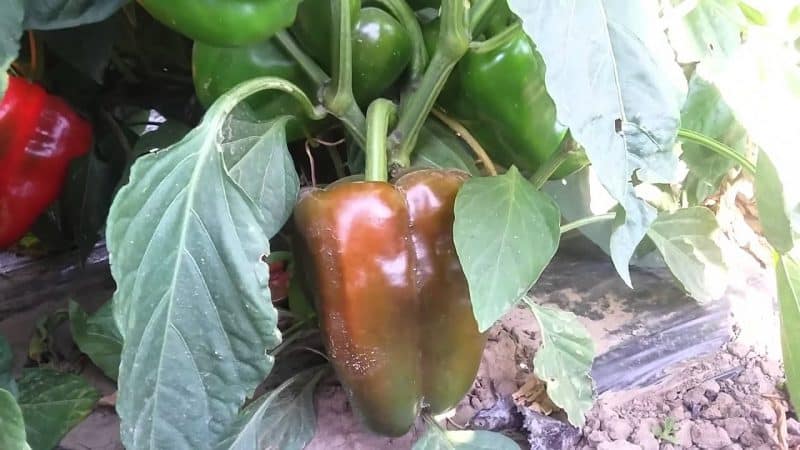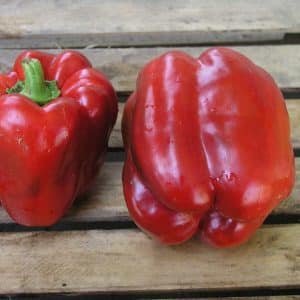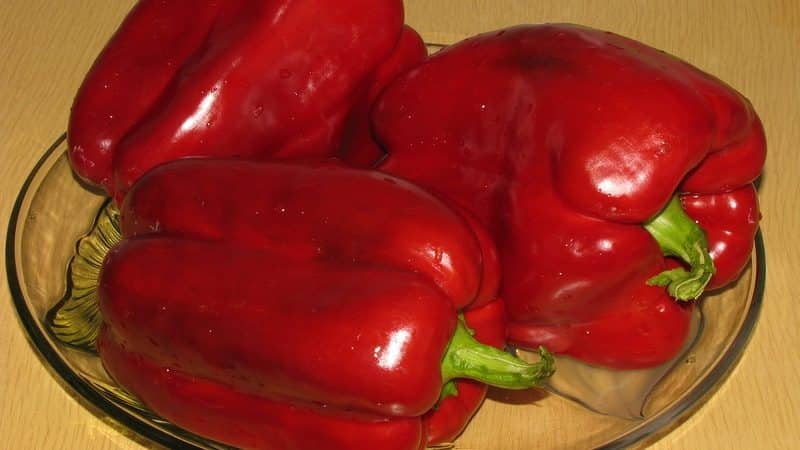Hybrid pepper “Claudio” from Dutch breeders and features of caring for it
Dutch varieties and sweet pepper hybrids are especially in demand among gardeners. The high quality of seeds, resistance to external adverse factors and pests allows us to speak of them as the best on the market.
We bring to your attention a review of Claudio pepper.
What kind of pepper is this
Claudio f1 is a highly productive hybrid of sweet pepper. When growing it, you can always count on a rich, healthy harvest, since it is able to form ovaries even under unfavorable conditions.
Characteristics and description
The species belongs to early ripening crops (no more than 115 days). The bushes are powerful, spreading, with large dark green wrinkled leaves. Height is about 70 cm. Each grows 10–12 fruits weighing up to 200 g with a wall thickness of 8–10 mm.
The plant feels great both in a greenhouse and in open ground. Seed germination is almost 100%. Can be grown both in greenhouses and in open ground.
The fruits are prismatic, with four chambers. They have high taste value.
The photo shows Claudio pepper f1.

Hybrid f1
The f1 hybrid is the result of long-term work by breeders. To obtain new types of crops, intraspecific plant crossings are carried out. The result of this work is new hybrids that are superior to their parents in key indicators: yield, taste, ripening time and, most importantly, disease resistance and frost resistance.
The F1 symbol present in the name of the Claudio pepper indicates that it is a first generation hybrid obtained from direct crossing of parent varieties. The hybrid form is highly productive. The description of the plant was officially included in the State Register of Russia in 2007.
Distinctive features
Claudio f1 is known to all experienced gardeners. Recommended for cultivation in the southern regions of the country. Has the following positive characteristics:
- is characterized by increased resistance to high ambient temperatures;
- suitable for long-term transport and can stored up to two months (if collected at the stage of technical maturity);
- seed germination is high (96–100%);
- good fertility of relatively small bushes;
- low rate of transition from the stage of technical maturity (green fruits) to the biological stage (bright red, characteristic of a ripe vegetable).
Fruit characteristics and yield
The hybrid produces glossy, drooping, prism-shaped fruits. Green at the stage of technical maturity and red at biological maturity. The weight of one pepper is 100–150 g. The walls are fleshy, juicy, 8–10 mm thick.
The yield, subject to all technological cultivation standards, is almost 300 c/ha.
Preparation for cultivation
Claudio pepper, like any nightshade, is grown from seedlings. Before planting, the seeds must be sorted and damaged ones removed. A mandatory procedure is to soak them in warm water until they swell. After this, they are transferred to a damp cloth or gauze, covered with a second layer and waited for 3–4 days.
After this, the planting material is treated with a biostimulant such as Epin, Zircon or Kornevin.
Attention! If the seeds are covered with a yellow shell, it means that the manufacturer has disinfected them in advance. It is not advisable to do this again.
Seeds are planted in boxes or cups with loose fertile soil. You can buy it in a store or make it yourself by mixing garden soil, sand and humus in equal proportions. Adding a small amount of wood ash has a good effect. The mixture is heated in the oven, allowed to cool and then distributed into cups or boxes. Depending on the region, pepper seedlings are planted from February to March.
Growing seedlings

Seeds are planted in prepared soil to a depth of about 2 cm. It is best to do this in separate pots, otherwise you will need to pick, during which you can damage the young roots of the plant and lose the harvest. After planting, the soil is watered and covered with film. For future seedlings, you need to choose a warm place.
After the first shoots appear, the film is removed. At this stage, the most important factor affecting the quality of future plants is temperature. Even at night it should not fall below 12°C. You can spray and water young peppers only with warm, settled water. The room in which the seedlings are located should be well ventilated and illuminated 10–12 hours a day.
Important! Many gardeners believe that growing seedlings in peat pots has a bad effect on the quality and strength of the adult plant.
If the plant was planted in a separate container, then after the first buds begin to form, it is immediately planted in open ground or a greenhouse.
If the seedlings were planted in a box, then picking is important.
This is an important event that allows you to:
- prevent the roots of different plants from intertwining;
- discard diseased and weak shoots at this stage, obtaining stronger bushes;
- ultimately reap more good harvests.
Picking should be done carefully and slowly. It is carried out at the stage of 2-3 true leaves, until the root system of the plant has formed. When transplanting into a new container, take into account the depth of the sprout in the previous container. You can’t dig the pepper down to the cotyledon leaves.
Immediately after transplantation, the plant will be under stress. It is better to remove it from direct sunlight for several days and ensure the ambient temperature is 20–22 °C. After 14 days, you can fertilize with ready-made fertilizer.
Important! Do not over-moisten the soil, otherwise root rot and plant death may occur.
Planting pepper
Peppers are planted in open ground at the end of May, when the air temperature does not drop below 15°C even at night. It is important to observe crop rotation. The best predecessors of pepper are pumpkin and zucchini. It is not advisable to plant after potatoes and eggplants. The plant prefers soil with low acidity, light and loose.
Claudio peppers are planted in small holes (without deepening the root collar) at a distance of 40 cm from each other. It is advisable to pour 1 tbsp into each hole. l. fertilizers high in nitrogen or phosphorus. At the end of planting, the plants are watered abundantly.
Further care
The Claudio hybrid is unpretentious, but to obtain a good harvest, some agrotechnical manipulations are required:
- removing lower leaves and providing good support;
- if the bush has formed from several stems, only the strongest ones are left (it’s best to pinch them with your hands);
- The flower grown on the first branch is removed, thereby increasing the yield.
- timely and abundant watering;
- loosening the soil under the bushes;
- The ideal temperature is 22–25°C.
- Until flowering, just one watering per week is enough; after the first flowers appear, watering is increased up to two times.
Features of cultivation and possible difficulties

Gardeners fell in love with the hybrid precisely because of its unpretentiousness. Claudio pepper is resistant to both diseases and external natural factors.
The main feature is that the strength and fertility of the bush directly depends on its formation. Pinching shoots and removing the first flower are important activities that should not be neglected.
Typical diseases and pests
Diseases and pests are generally standard for the entire species.
In conditions of high humidity, fungal diseases develop. To combat, reduce watering and spray the bushes with Barrier and Oxyx. Repeated treatment is necessary after 20–25 days.
Reference. Hybrid Claudio f1 is not susceptible to such a dangerous disease as tobacco mosaic.
Often the plant is attacked by the main garden pests: aphid, wireworm and spider mite.
An infusion of onion peels helps against spider mites.
A solution of wood ash works well against aphids.
For wireworms, they set traps from sweet root vegetables, which they like more than pepper.
Advantages and disadvantages
Claudio pepper is valuable for its fruits. Large, thick-walled, thin-skinned peppers have a bright aroma and excellent taste. Early ripening crop with a growing season of 80 days. Shows high productivity. Resistant to diseases and pests.
The hybrid easily tolerates temperature changes. Not afraid of sunburn and frost.Hard fruits are suitable for long-term transportation.
It can be grown both in greenhouses and in open ground.
It would seem that this is an ideal pepper hybrid, however, it also has disadvantages. You can get a good harvest only by devoting enough time to growing the crop. The bush requires feeding, loosening, watering and garter. The level of lighting is important. Only with proper care can you reap a decent harvest.
The fruits have good shelf life only if collected during the period of technical ripeness. Peppers collected at the moment of biological maturity cannot be stored for long.

Reviews
Gardeners who have tried to grow the Claudio hybrid are generally satisfied with the resulting harvest.
Irina, Ryazan: «I bought Claudio pepper seeds at a specialty store on the advice of a neighbor. I wasn't disappointed. The fruits began to ripen quickly, fleshy, bright red in color. Prepared for the winter and used in salads all summer.”
Tamara, Ivanteevka: “Claudio pepper has been ripening on my plot for several years now. I plant only in a greenhouse, so the harvest ripens two weeks earlier than in open ground. Of course, the hybrid requires attention: watering, fertilizing, treating so that the bushes do not get sick. But the result does not disappoint. Large, fleshy peppers delight the eye and heart.”
Vladimir, Kostroma: “I’ve been trying to grow Claudio peppers on my plot for the second season. In general, I like the hybrid: tasty fruits, fleshy, bright red. But they ripen longer than stated in the manufacturer’s description.”
Conclusion
Hybrid Claudio f1 was bred by Dutch breeders 20 years ago, but is still popular among gardeners today. The plant is high-yielding and produces sweet, aromatic fruits.The hybrid is valued for its early ripening and versatility of use.
To appreciate the taste of pepper, it is important to spend the right amount of time caring for the bush. If you approach the cultivation of the hybrid responsibly, this particular pepper can become the most beloved guest in the garden.